NAB Show Product Review: Camera Support
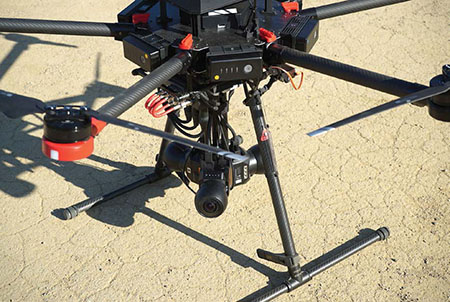
360 Designs Flying EYE VR
Where the past couple of NABs have seen all sorts of drone camera platforms, some little more than toys, the 2017 exhibit floor saw fewer but more targeted unmanned aerial vehicles.
DRONES
360 DESIGNS demonstrated its Flying EYE VR drone, designed to fly the company’s MiniEYE 3 and other three-camera VR rigs. Its ground station provides stitched 4K SDI, 6K NDI, and 6K H.265 (HEVC) outputs. The maximum distance for receiving live video from the flying drone is three to six miles.
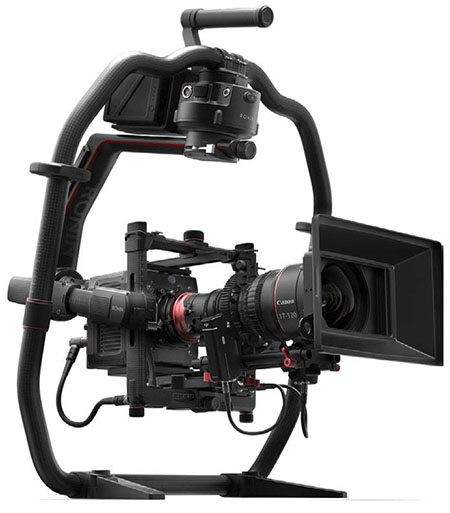
DJI RONIN 2
DJI’S new flagship RONIN 2 camera drone represents a major reworking of almost everything seen in its previous version. A handy carbon fiber ring on the drone allows the operator to easily set the drone down. Payload has been increased to 30 pounds, and telescoping arms allow for much larger cameras and zoom lenses than previously possible.
DRONE VOLT showed the tethered drone Hoverfly system. Where an untethered unmanned aerial vehicle may provide more freedom in terms of where the aircraft goes, flight time is limited to what the system’s batteries will handle.
FREEFLY SYSTEMS unveiled the Pilot System, a modular version of the MoVI Controller. The system allows users to configure in a variety of setups based on their specific needs. Modules are available for a single axis lens controller as well as a handle module for complete control of focus, iris, zoom and MoVI settings.
POWER VISION showcased its Power Ray, an underwater tethered drone. It can operate and image to a 64 GB SD card for four hours on a battery, and dive to a 100-foot depth. It can stream HD video to the surface, while recording 4K on the drone in the depths. Tethering cables for control are available in 150 and 210 foot lengths.
CAMERA STABILIZERS
FREEFLY SYSTEMS rolled out its MoVI Pro, providing a number of improvements over the original MoVI family, including hot swappable batteries. Also new is an integrated stand to allow quick parking and retrieving the MoVI. Also featured are stronger motors, integrated RED camera control and a built-in LCD screen allowing for auto-tuning and further adjustments.
GLIDECAM launched its Tru-Horizon stabilizer, which facilitates a move from low mode to high mode, and back again, in one single fluid shot while the camera automatically remains level and horizontal at all times.
STEADICAM premiered its Volt stabilizer, designed to stabilize GoPro and smartphones. It uses internalized gyro technology to allow the user’s hand to be the driving mass to stabilize the shot, while the unit does all the leveling.
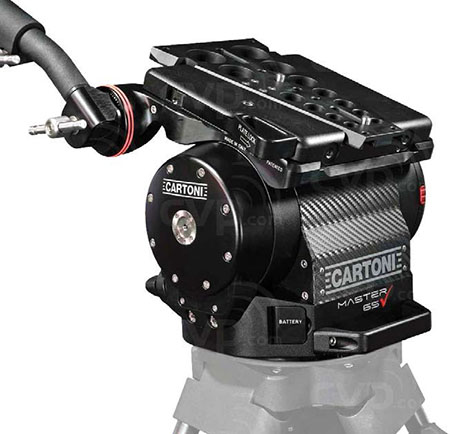
Cartoni Master 65 fluid head
TRIPODS/MONOPODS
CARTONI introduced the Master 65 fluid head, designed to support heavy camera packages with large zoom lenses. It uses a new drag system, has a payload range of 44–143 pounds, and includes Cartoni’s Magnum counterbalance system, which provides perfect balance throughout the full +/- 90 degree tilt range with no dead spots.
LIBEC USA presented its HFMP (Hands-Free Monopod), specially designed for free-stand operations. The free-stand base located at the bottom of the monopod allows users to instantly switch the monopod’s function from shooting mode to a locked vertical position in a single step.
MILLER CAMERA SUPPORT introduced the arrowFX 3, arrowFX 5 and arrowFX 7 fluid heads that feature integrated robust, high-resolution magnetic encoders, allowing precise monitoring and communication, in real time, of the exact position of the fluid head with zero latency. Miller also featured its Skyline 90 Fluid Head, a heavyduty head designed for outside broadcasting with counterbalance control ranging from zero to 165 pounds, and 300mm of sliding range.
ROBOTICS
GEARHOUSE BROADCAST, in conjunction with its partners TELESCOPIC LLC and Big Shot Camera Cranes, introduced the SkyTechno Inverted Telescoping Camera Crane. Targeting AR/VR production requirements, the 24-foot crane employs the latest encoding technology to ensure that 3D graphics are inserted into the live camera feed exactly where and when needed.
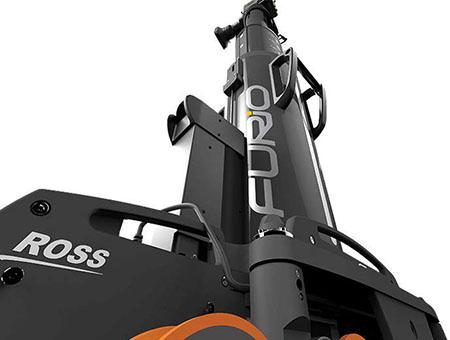
Ross Furio SE rail-based dolly system
ROSS VIDEO introduced the Furio SE rail-based dolly system, the next generation of its Furio robotic camera system. The new system incorporates more than 40 new features, enhancements, or performance improvements, and includes a number of new technologies. The carbon-fiber lift is more than 20 percent.
Also new is the Furio SE BlackBird, a smooth-rolling, ultra-stable base for the Furio SE lift and VR100/VR600 heads.
RUSHWORKS demonstrated its LOCKED ON object tracking solution that controls one or more PTZ or PTX fixtures, allowing them to follow on-air talent with no operators required. The technology utilizes predictive motion and acceleration/deceleration data to emulate the camera work of skilled and well-trained camera operators.
SHOTOKU partnered with jib-arm maker CamMate to develop the Graphica series of VR/AR tracked camera cranes. Graphica calculates positional data output from embedded physical rotary encoders designed specifically for VR. Also new is the Free-d2 Absolute Tracking System, which uses advanced video processing algorithms and ceiling markers to precisely determine the exact position and orientation of the studio camera.
TELEMETRICS launched its PTHP-55 Robotic Pan/Tilt Head, a lower-cost addition to the company’s robotic camera support equipment. The head can accommodate a 40-pound camera and lens payload, and is fully 4K-ready with embedded fiber as standard. The company also debuted its Televator EP7 Series, available in three sizes to accommodate virtually any camera and height position.
VINTEN’S Vantage compact robotic head has been added to the VitecEV all-new Creative Studio, a fully integrated video capture and streaming solution designed for use in an enterprise setting. Vinten also debuted its micro VRC controller, designed to be paired with Vantage to provide a complete robotic camera solution.
PROMPTING
AUTOSCRIPT unveiled Intelligent Prompting, its completely IP-enabled teleprompting solution. The system avoids the use of video-over-IP and ensures that much less data is sent over the IP network. The intelligence needed to generate the script has been incorporated inside every Intelligent Prompting monitor, enabling the monitor to produce the video output directly.
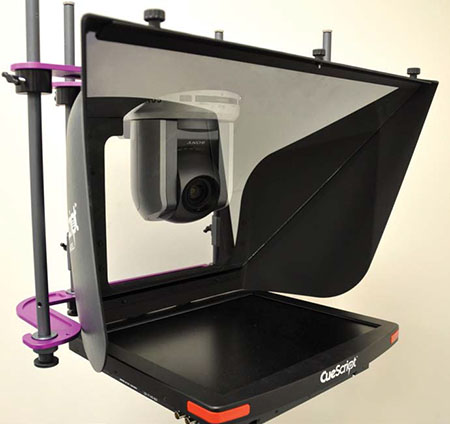
Cuescript PTZ Prompter System
CUESCRIPT debuted its PTZ Prompter System, in which the PTZ camera mounts upside down in the top of a specially designed prompter hood, providing greater movement for the camera and eliminating the need for expensive tripods. The company also demonstrated CueiT, a complete IP-based prompting solution, along with the CueB engine that provides connection via Ethernet or USB, allowing nearly limitless scroll controllers that can also be connected over IP.
MIRROR IMAGE demonstrated its IP10 iPad teleprompter, which features the same wide-angle mirror, heavy-duty lens hood and fully adjustable camera mount as the company’s high-end teleprompters.
MISCELLANEOUS
MATTHEWS STUDIO EQUIPMENT unveiled the Elevator, designed to allow productions to create vertical camera moves on a budget. It features a counterbalanced elevation tower that provides 25.5 inches of smooth vertical movement with simultaneous 360-degree panning. Also on display at MSE was the My Way Rigging System, a two-part interchangeable rigging system designed to speed setups.
Get the TV Tech Newsletter
The professional video industry's #1 source for news, trends and product and tech information. Sign up below.
